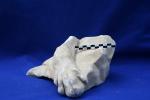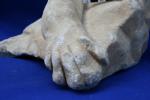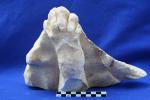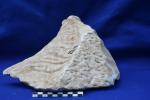
Description
- 900
- recumbent miniature panther, landscaped base, fragment
- 2nd-3rd c. AD
- White marble.
- Roughly triangular fragment. Maximum w. 20 cm; leg. w. 6.5 at the back break, tapering to 4.5 at the wrist bone; l. ca 14.5-15 cm
- Finished edges preserved of the triangular base spur, cut away at the back. The leg is broken away near the lower elbow joint. A more recent break at the joint of the leg left a scar, upon the otherwise evenly weathered surface with its grey-brown light encrustation. The outer left digit of the paw was broken before weathering.
- It is likely that this miniaturised paw and foreleg belonged to a panther, which in turn belonged to a larger group, possibly of Dionysus and/or a satyr/ faun,.The crouched panther is sprawled recumbent, its leg spread out onto its own separate base spur, ‘landscaped’ to denote wilderness. Its faceted surface continued on the receding sides, suggesting that the original base was naturalistically irregular - an unusual touch in Roman ‘landscape’ bases.
- The piece comes from the winery zone, like the other two panther fragments. The small body is larger than the miniature panther S 18, but still smaller than the life-sized panther S 20. Feline attendants of Dionysos or his entourage were most commonly depicted sitting up on their haunches, with one forepaw raised in reaction to liquid spilling from a cup dangling in the god’s hand. Here, however, the animal is recumbent. The miniature scale perhaps suggests a Hadrianic date at the earliest. The taut skin over verist skeletal articulation and veining is consistent with a 2nd or 3rd c. date.
- LIMC III sv. Dionysus as for S 20.
Record Details
-
VM_7508
- strato di terra pietre, terra e frammenti di laterizi.














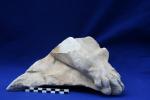
![Download [view]](/villamagna/ark//skins/villamagna/images/results/download_sml.png)
